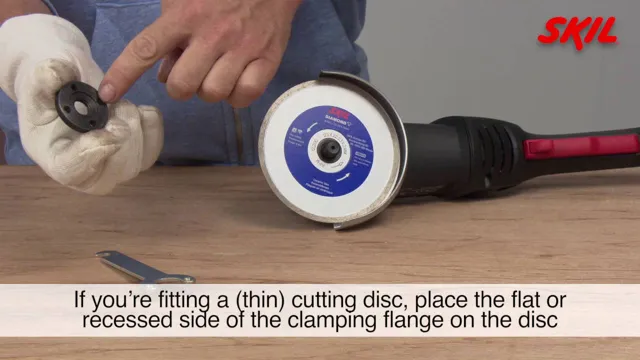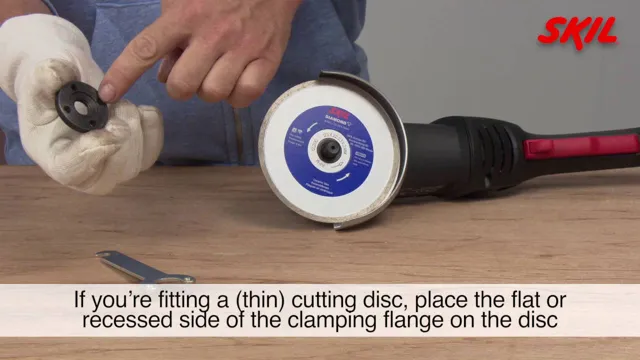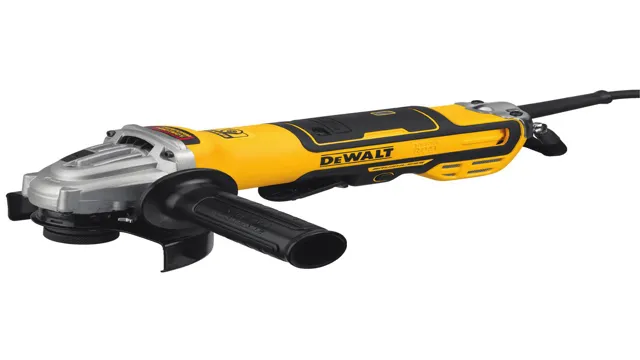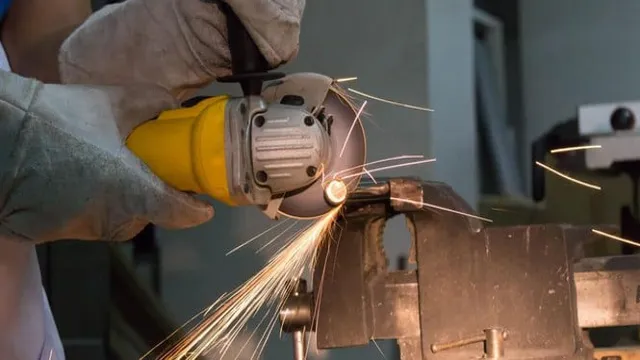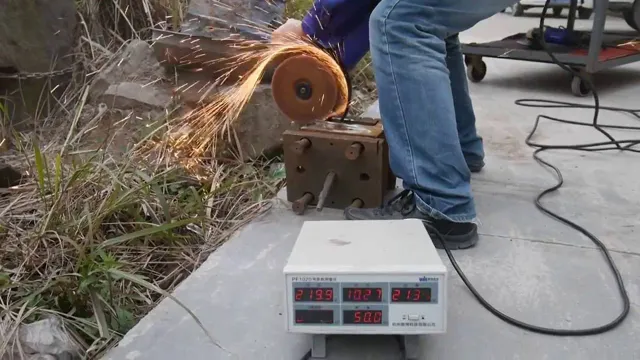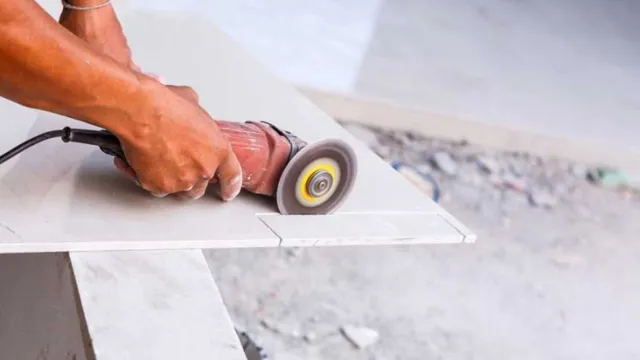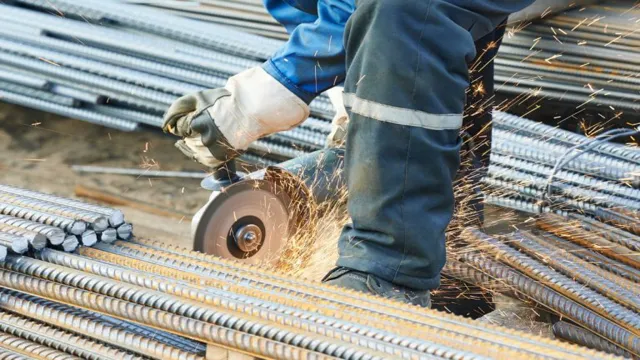What Are Angle Grinder Discs Made of? A Comprehensive Guide to Disc Materials
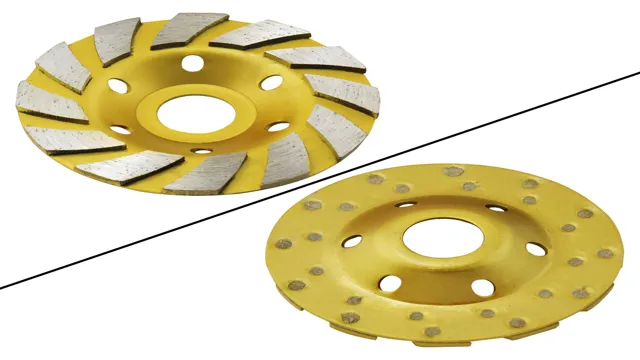
If you’re a DIY enthusiast, it’s likely that you own an angle grinder or are considering purchasing one. Angle grinders are often the go-to tool for grinding, cutting, and polishing various materials, including metal, concrete, and stone. Angle grinder discs are an essential component of these tools, but many people wonder what they are made of.
Is it plastic, metal, or some kind of composite material? Understanding what angle grinder discs are made of will help you choose the right disc for the job, ensuring you obtain the best results. Angle grinder discs are typically made of three materials: abrasive, diamond, or carbide. The abrasive discs are made of various composite materials, including sandpaper and reinforced fibers.
On the other hand, the diamond discs consist of a metal plating with embedded diamond crystals, making them ideal for cutting hard materials such as concrete. And carbide discs, which are made of tungsten and carbide particles, are durable and long-lasting, making them perfect for cutting through metal and other tough materials. Choosing the right disc for your angle grinder is a crucial aspect of ensuring that you get the desired results.
Therefore, it’s always essential to know what each disc is made of and whether it’s suitable for the job at hand. With this knowledge, you can ensure that your angle grinder is as effective and efficient as possible.
Introduction
Angle grinder discs are essential accessories used in various metalworking applications. They are made of various abrasive materials, each with unique characteristics that determine their suitability for specific tasks. Common materials used in making angle grinder discs include aluminum oxide, zirconia alumina, ceramic alumina, and silicon carbide.
Aluminum oxide is a cost-effective option suitable for general-purpose grinding on ferrous metals, while zirconia alumina discs are best suited for heavy stock removal on ferrous and nonferrous metals. Ceramic alumina discs are ideal for high-pressure applications, while silicon carbide discs are perfect for grinding stone, concrete, and masonry materials. Choosing the correct angle grinder disc for your task will ensure the job is performed correctly, efficiently and prevent damage to the tools and materials used.
It is essential to consider the task’s requirements and material properties when selecting the best angle grinder disc for your application.
– Basic Information on Angle Grinder Discs
Angle grinder discs are an essential tool in any metalworking or construction project. These discs come in various types, each designed for specific tasks. The abrasive wheel is the most commonly used type and is best for cutting, grinding and polishing metals.
Diamond discs are ideal for cutting through hard surfaces such as concrete and stone. Wire brushes and sanding discs are perfect for smoothing out rough surfaces, rust removal and cleaning. It is important to choose the right type of angle grinder disc for the job to ensure the best results.
Always read the manufacturer’s instructions and follow safety precautions when using angle grinder discs. Safety glasses, gloves and protective clothing should be worn at all times to prevent injury. Proper usage and maintenance can increase the lifespan of angle grinder discs ensuring safe and efficient performance.
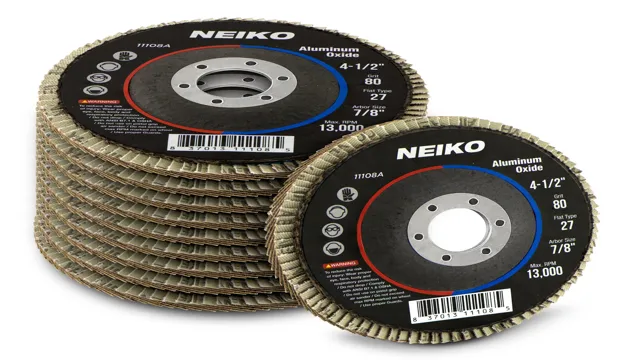
Types of Angle Grinder Discs
Angle grinder discs are made of various materials, each with different properties to suit specific tasks. The most common materials used in angle grinder discs are aluminum oxide, zirconia alumina, and ceramic alumina. Aluminum oxide discs are the most affordable and are ideal for grinding and cutting metal surfaces.
Zirconia alumina discs are stronger and more durable, making them suitable for heavy-duty grinding tasks. They are also efficient for cutting through hard materials such as stainless steel and cast iron. Ceramic alumina discs, on the other hand, are the most expensive but have the highest durability and speed.
They are ideal for cutting through hard materials and continuous use. Depending on the task at hand, it is important to select the appropriate angle grinder disc material to not only achieve the desired result but also to ensure the safety of the user.
– Cutting Discs
Cutting Discs Angle grinders are versatile and powerful tools commonly used in metalworking, construction, and woodworking. However, their effectiveness is highly dependent on the type of cutting disc you use. Cutting discs come in different shapes, sizes, and materials, each designed for specific cutting applications.
Some of the most common cutting discs for angle grinders include abrasive, diamond, and carbide discs. Abrasive discs are ideal for cutting and grinding metal, concrete, and other materials. Diamond discs, on the other hand, are perfect for cutting hard and tough materials such as ceramic tiles and stone.
Lastly, carbide cutting discs are the go-to option for cutting through wood and other soft materials. When selecting a cutting disc, be sure to consider the material, thickness, and size of the disc, as well as the power and speed of your angle grinder. With the right cutting disc, you can achieve clean and precise cuts, work efficiently, and ensure safety while using your angle grinder.
– Grinding Discs
Angle grinder discs come in a variety of shapes and sizes, each designed to perform specific tasks. One of the most common types of discs is the grinding disc, which is used for grinding and smoothing non-ferrous metals such as aluminum, brass, and copper. Grinding discs can also be used to remove rust and other types of corrosion from metal surfaces.
There are different types of grinding discs available, including diamond-discs and abrasive discs. Diamond discs are ideal for cutting through tough materials, while abrasive discs are designed to remove material quickly. When choosing an angle grinder disc, it’s important to consider the type of project you will be working on and the materials you will be working with.
This will help you find the best disc for the job and ensure that you achieve the desired results.
– Sanding Discs
Angle grinder discs are essential tools for any DIY project involving sanding, cutting, grinding, or polishing. Among the various types of angle grinder discs, sanding discs are widely used in woodworking, metalworking, and auto body restoration. These discs come in various grit sizes, ranging from coarse to fine, and can be made of different abrasive materials, such as aluminum oxide, silicon carbide, and zirconia alumina.
The choice of sanding disc depends on the type of material being worked on and the desired level of finish. For instance, coarse grits are suitable for heavy-duty sanding tasks, while finer grits are ideal for finishing and polishing. Regardless of the grit size, sanding discs should always be used with appropriate safety gear, such as gloves, eye goggles, and dust masks, as they can generate a considerable amount of dust and debris.
Overall, sanding discs are versatile accessories that can enhance the functionality and performance of an angle grinder.
– Wire Brush Discs
Angle Grinder Discs When it comes to angle grinders, the type of disc you use determines the task that you can perform. There are several kinds of angle grinder discs available, each designed for a specific purpose. For instance, abrasive discs are used for cutting and grinding metal and ceramic materials, while diamond discs are better suited for concrete and stone surfaces.
Flap discs are suitable for polishing and deburring tasks and are ideal for removing rust and paint from metal surfaces. Wire brush discs, on the other hand, are perfect for cleaning and removing paint and rust from steel surfaces. Whatever angle grinder disc you need, make sure to choose the right one for the job to ensure a safe and efficient tool operation.
Materials Used in Angle Grinder Discs
Angle grinder discs are used for cutting and grinding various materials, including metal, concrete, and stone. These discs are typically made from abrasive materials such as aluminum oxide, silicon carbide, or zirconia alumina. Aluminum oxide discs are the most common and can be used for general purpose grinding and polishing.
Silicon carbide discs are used for grinding harder materials such as marble, granite, or concrete. Zirconia alumina discs are the most durable and can handle heavy-duty grinding applications. Additionally, angle grinder discs can come in various shapes and sizes, allowing for precision cutting and shaping of different materials.
It is important to select the appropriate disc for the material being worked on to ensure maximum efficiency and safety. Overall, angle grinder discs are essential tools for any DIY enthusiast or professional tradesperson.
– Aluminum Oxide
Aluminum Oxide When it comes to materials used in angle grinder discs, aluminum oxide is a popular choice due to its durability and versatility. This mineral is a type of abrasive grain that is capable of handling heavy-duty grinding tasks on a variety of surfaces, including metal, wood, and concrete. Aluminum oxide is prized for its hardness and ability to retain its sharp edges, which allows it to maintain its performance over long periods of use.
It also generates minimal amounts of heat during grinding, making it a popular choice for extended use. Whether you’re working on a construction project or need a reliable abrasive for DIY tasks, aluminum oxide is a dependable choice for angle grinder discs.
– Zirconia Alumina
Zirconia alumina is a popular material used in angle grinder discs. It’s a durable and hard-wearing material that can withstand a lot of wear and tear, making it ideal for heavy-duty grinding and cutting. The material is made by fusing zirconia with alumina, creating a material that has the best of both worlds.
Zirconia alumina discs are known for their excellent grinding performance, and they can tackle even the toughest materials with ease. Whether you’re a professional tradesperson or a DIY enthusiast, a zirconia alumina angle grinder disc is an excellent choice for all your grinding needs. So, if you’re looking for a reliable and efficient grinding disc, consider the zirconia alumina option.
– Ceramic Alumina
Ceramic Alumina is a popular material used in angle grinder discs. This material is known for its high durability and toughness, which makes it ideal for use in applications that require heavy grinding and cutting. Ceramic Alumina is made by mixing aluminum oxide with other materials to create a tough and dense product.
One of the main advantages of Ceramic Alumina is that it can operate at higher speeds than other grinding materials, which makes it a go-to choice for many professionals. It is a cost-effective material that can provide long-lasting performance. With its strong and durable build, Ceramic Alumina can tackle tough jobs without losing its edge.
Angles grinders that are equipped with discs made of Ceramic Alumina can cut through materials like steel and concrete with ease. Additionally, it can offer a smooth finish while grinding or cutting. Overall, Ceramic Alumina is a dependable material used in angle grinder discs that can tackle the toughest of jobs.
– Silicon Carbide
Angle grinder discs are essential tools for DIY enthusiasts and professionals alike. These discs are made of various materials, each with its own strengths and weaknesses. Silicon carbide is a popular material used in angle grinder discs due to its high cutting speed and durability.
It is made of crystalline silicon carbide and can be used for grinding, sanding, and finishing all sorts of surfaces, including concrete, tiles, and metals. Silicon carbide discs are also heat-resistant and can withstand high temperatures, making them perfect for heavy-duty tasks. However, they tend to wear out quickly, making them unsuitable for extended use.
Nonetheless, silicon carbide discs are perfect for tasks that require fast and efficient material removal.
Conclusion
So, what are angle grinder discs made of? Well, the answer is simple – it depends! These powerful cutting tools can come with a variety of different discs, each made from specific materials for specific purposes. From basic aluminum oxide discs for everyday use to diamond-tipped blades for cutting through tough materials like concrete, the possibilities are endless. But one thing is for sure, no matter what the disc is made of, the angle grinder is a versatile and essential tool for any DIY enthusiast or professional tradesperson.
So next time you’re cutting through metal or grinding down concrete, take a moment to appreciate the carefully crafted disc spinning at your fingertips – it’s the real star of the show!”
FAQs
What materials are commonly used to manufacture angle grinder discs?
Angle grinder discs can be made of different materials such as aluminum oxide, silicon carbide, zirconia alumina, and ceramic alumina.
What is the most suitable disc material for cutting stainless steel with an angle grinder?
Zirconia alumina or ceramic alumina discs are known to perform well when cutting stainless steel with an angle grinder.
Can angle grinder discs be used on other types of power tools?
Depending on their size and compatibility, angle grinder discs can be fitted onto other power tools like rotary tools, drills, and cut-off saws.
How do I know which abrasive disc to use for specific applications?
Manufacturers often label their abrasive discs to indicate their recommended applications. Reading the labels or consulting product manuals can provide guidance on which disc to use for specific tasks.
What safety precautions should I follow when using an angle grinder with discs?
Some safety precautions when using an angle grinder with discs include wearing appropriate protective gear like goggles, gloves, and masks, securing the workpiece properly, and being aware of the speed and direction of the grinder.
Can angle grinder discs be used for grinding and polishing tasks as well?
Yes, some discs are designed for grinding and polishing tasks like metal polishing, rust removal, and surface preparation for painting.
What is the average lifespan of an angle grinder disc?
The lifespan of an angle grinder disc depends on various factors like its material, quality, and frequency of use. On average, a disc can last for a few hours to several months. However, it is recommended to regularly inspect discs for damages, wear, and tear and replace them when needed.

